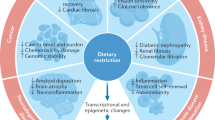Abstract
The possibility is discussed that dietary restriction modulates ageing and onset of related pathologies by, in addition to upregulation of proteolysis, suppression of glycolysis which in turn decreases generation of methylglyoxal (MG), a highly toxic glycating agent which can provoke cellular senescence and many age-related pathologies. This proposal is supported by the observation that intermittent feeding can mimic dietary restriction’s effects on mouse lifespan without any overall reduction in calorie intake. That MG-induced modification of the chaperone and anti-apoptotic protein (Hsp27) increases its protective functions suggests a possible hormetic response to transient MG production during transient periods of glycolysis in dietary restricted animals. It is suggested that in the ad libitum-fed state permanent glycolysis would suppress proteolysis and continuously generate MG which overwhelms the anti-MG defence systems. It is proposed that periods of fasting might be a more acceptable approach than permanent undernutrition in our attempts to slow human ageing, although timing of meals may prove important.
Similar content being viewed by others
References
Chondrogianni N, Gonos ES (2004) Proteasome inhibition induces a senescence-like phenotype in primary human fibroblast cultures. Biogerontol 5:55–61
Goodrick CL, Ingram DK, Reynolds MA, Freeman JR, Cider N (1990) Effects of intermittent feeding upon body weight and lifespan in inbred mice: interactions of genotype and age. Mech Ageing Dev 55:69–87
Hipkiss AR (2006) On the mechanisms of ageing suppression by dietary restriction––is permanent glycolysis the problem? Mech Ageing Dev 127:8–15
Holliday R (2006) Food, fertility and longevity. Biogerontol 7:139–141
Klionsky DJ (2006) Good riddance to bad rubbish. Nature 44:819–820
Le Bourg RJ, Minois N (2005) Does dietary restriction really increase longevity in Drosophila melonogaster? Ageing Res Rev 4:409–421
Liu BF, Miyata S, Hirota Y, Higo S, Miyazaki H, Fukunga M, Hamada Y, Ueyama S, Muramoto O, Uriuhara A, Kasuga M (2003) Methylglyoxal induces apoptosis through activation of p38 mitogen-activated protein kinase in rat mesangial cells. Kidney Int 63:947–957
Maruyama N, Ishigami A, Kondon Y, Sato Y, Kubo S (2005) Functions of SMP30 as anti-ageing molecule. In: 11th congress of the international association of biomedical gerontology, University of Aarhus, Denmark, abstract, p 93
Masternak MM, Al-Regaiey KA, Bonkowski MS, Panici JA, Bartke A (2005) Effect of every other day feeding diet on gene expression in normal and in long-lived Ames dwarf mice. Exp Gerontol 40:491–497
Matsuyama S, Kitamura T, Enomoto N, Fujita T, Ishigami A, Handa S, Maruyama N, Zheng D, Ikejima K, Takei Y Sato N (2004) Senescence marker protein30 regulates Akt activity and contributes to cell survival in HerG2 cells. Biochem Biophys Res Commun 321:386–390
Mattson MP, Wan R (2005) Beneficial effects of intermittent feeding and caloric restriction on the cardiovascular and cerebrovascular systems. J Nutr Biochem 16:129–137
McCarter RJ, Palmer J (1992) Energy metabolism and aging: a lifelong study of Fischer 344 rats. Am J Physiol 263:E448–E452
Mockett RJ, Cooper TM, Orr WC, Sohal RS (2006) Effects of caloric restriction are species specific. Biogerontol 7:157–160
Oya-Ito T, Liu B-F, Nagaraj RH (2006) Effect of methylglyoxal modification and phosphorylation on the chaperone and anti-apoptotic properties of heat shock protein 27. J Cell Biochem 99:279–291
Ramasamy R, Yan SF, Schmidt AM (2006) Methylglyoxal comes of AGE. Cell 124:258–260
Riboulet-Chavey A, Pierron A, Durand I, Murdaca J, Giudicelli J, Van Obberrghen E (2006) Methylglyoxal impairs the insulin signalling pathways independently of the formation of intracellular reactive oxygen species. Diabetes 55:1289–1299
Stroikin Y, Dalen H, Brunk UT, Terman A (2005) Testing the “garbage” accumulation theory of ageing: mitotic activity protects cells from death induced by inhibition of autophagy. Biogerontol 6:39–47
Weindruch R (2006) Will dietary restriction work in primates? Biogerontol 7:169–171
Yao D, Taguchi T, Matsumura T, Pestell R, Edelstein D, Giadino I, Suske G, Ahmed N, Thornalley PJ, Sarthy VP, Hammes H-P, Brownlee M (2006) Methylglyoxal modification of mSin3A links glycolysis to angiopoietin-2 transcription. Cell 124:275–286
Yu BP (2006) Why calorie restriction would work for human longevity. Biogerontol (in press)
Author information
Authors and Affiliations
Corresponding author
Rights and permissions
About this article
Cite this article
Hipkiss, A.R. Dietary restriction, glycolysis, hormesis and ageing. Biogerontology 8, 221–224 (2007). https://doi.org/10.1007/s10522-006-9034-x
Received:
Accepted:
Published:
Issue Date:
DOI: https://doi.org/10.1007/s10522-006-9034-x




